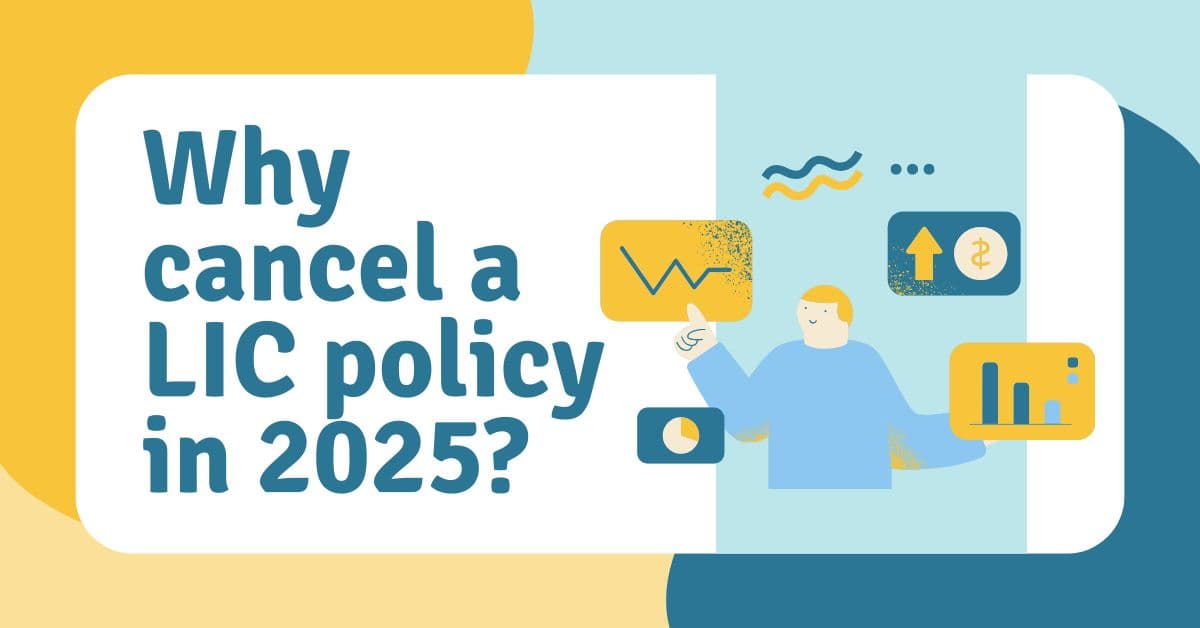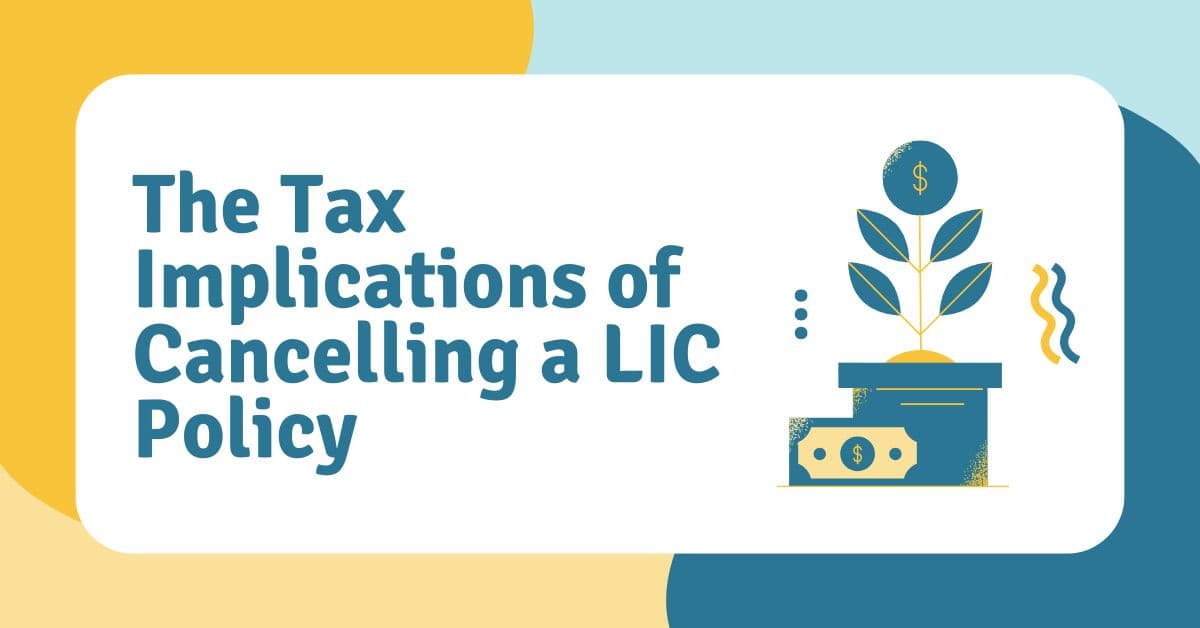LIC Cancellation Form: The Life Insurance Corporation of India (LIC) is fundamental to financial planning for several Indian households, providing life insurance and investment schemes. However, many policyholders are thinking of terminating (surrendering) their LIC policies in 2025 in order to reroute funds into higher-return investments or to take care of urgent financial responsibilities due to growing financial literacy and changing economic demands. In addition to completing a surrender form (Form 5074), cancelling a LIC policy has tax ramifications that, if not handled carefully, might negatively affect your financial situation.
This guide, presents a thorough process for terminating a LIC policy using Form 5074, details the tax ramifications, and suggests a tax-efficient way to maximise your financial plan. With its wealth of useful advice, insights unique to India, and useful tools, this post enables both novice and experienced investors in Tier-2 towns, Mumbai, Delhi, and other cities to successfully traverse the LIC cancellation procedure and make wise financial decisions in 2025.
Why cancel a LIC policy in 2025?
When a LIC policy is cancelled, often referred to as surrendered, it is terminated prior to maturity in order to obtain the surrender value, which is a percentage of the premiums paid less costs. Indian policyholders may think about cancelling for a number of reasons.

- Financial constraints: High premiums (₹20,000–₹50,000/year) put a strain on budgets, particularly when combined with EMIs (₹10,000–₹50,000) or the expense of living in the metro area (rent: ₹15,000–₹30,000).
- Better Investment Options: Sovereign Gold Bonds (7–10% yields) and equity mutual funds (~12% CAGR) perform better than LIC’s conventional plans (5–6% IRR).
- Changing priorities include the need for liquidity for medical emergency (₹50,000–₹5 lakh), weddings (₹10–20 lakh), and schooling (₹5–15 lakh).
- Regulation Misalignment: Impulsively purchased endowment or money-back plans don’t connect with contemporary objectives like retirement or wealth accumulation.
Context: LIC is still a reliable option with 2.19 crore policies sold in FY 2019–20 and a 98.2% claim settlement percentage, but cancellations are increasing as investors look for flexibility and greater returns in the face of inflation (4–6%).
Be advised that surrendering removes life insurance and lowers returns (surrender value: 30–50% of premiums). Careful tax preparation is necessary to limit obligations.
Being Aware of the LIC Cancellation Procedure
You must submit Form 5074 (Surrender Discharge Voucher) together with the necessary paperwork in order to terminate a LIC insurance. This is a detailed handbook for investors from India.
Step 1: Verify Your Cancellation Eligibility
For policies to be eligible for surrender, minimum premium payment periods must be met:
After two years, single premium plans are surrenderable.
Standard Premium Plans:
- Policies with a 10-year term: Give up after two years of paying premiums.
- Policies longer than ten years: Give up after three years of paying premiums.
Unit-Linked Plans (ULIPs): Usually, such as LIC SIIP, surrender after a five-year lock-in period.
Context: Three years’ worth of premiums are needed to renounce popular LIC plans like Jeevan Anand, Jeevan Labh, or New Endowment Plan. Examine your policy papers or call the LIC hotline (1800-33-4433) to speak with a LIC representative.
Step 2: Calculate the Surrender Value
The sum due upon cancellation is known as the surrender value, and it is determined by taking the higher of:
About 30% of the total premiums paid, minus taxes, rider premiums, and first-year premiums, is the guaranteed surrender value (GSV).
Special Surrender Value (SSV): Determined by LIC using a Surrender Value Factor (SVF), bonuses, and the total assured:
- 80% of the maturity amount is guaranteed in 3–4 years.
- 90% of the maturity amount is guaranteed in 4–5 years.
- Bonuses accumulated after five years are included (greater SVF).
Formula: Basic Sum Assured × (Premiums Paid / Total Premiums Payable) + Bonus} × SVF is the formula for SSV.
For instance:
- Policy: 5 years, ₹50,000 premium each year, ₹10 lakh amount guaranteed.
- A total of ₹2.5 lakh was spent on premiums.
- GSV: ₹60,000 (30% of ₹2 lakh, excluding the first year).
- SSV: SSV = (₹10 lakh × 5/20 + ₹1 lakh) × 50% = ₹1.75 lakh if SVF is 50% and bonus is ₹1 lakh.
- Surrender Value (greater of GSV/SSV): ₹1.75 lakh.
Context: Because of the low SVF, early surrenders (one to three years) return almost nothing. For estimates, contact a branch or use LIC’s Surrender Value Calculator on their website.
Step 3: Compile the necessary paperwork
Send the following paperwork to the LIC branch that serves you:
- LIC Surrender Discharge Voucher Form 5074: accessible in branches or online.
- Original Policy Document: Provide an indemnification bond or affidavit if it is lost.
- Cancelled Cheque: For NEFT payment, provide the policyholder’s name.
- KYC documents include a passport, PAN, or Aadhaar.
- Provide a justification (such as “financial hardship”) in the surrender request letter.
- For direct bank transfers, use the NEFT Mandate Form.
Context: RBI regulations need KYC compliance. Due to restricted branch access, investors in rural areas might have to courier papers.
Step 4: Get Form 5074 and fill it out
The formal surrender paperwork is Form 5074. Take these actions:
Get the Form Here:
- Visit the “Customer Portal” section of LIC’s website. “Policy Servicing” > “Download Forms” > “Form 5074.”
- Pick up at one of the 2048 LIC branches.
Fill Out Information:
- Name, address, and phone number of the policyholder.
- Details of the policy: policy number, amount of premiums, and sum assured.
- A succinct justification for the surrender, such as “moving to term insurance.”
- Bank Information: Bank name, IFSC code, and account number.
- Signature: Verify insurance documents; for policyholders who are illiterate, take a thumb impression with a witness.
Check Accuracy: Processing is delayed by errors.
Context: Branch visits may be necessary due to internet connectivity problems in rural locations (such as Bihar and Odisha). To amend forms online, use tools like Doc Hub or pdf Filler.
Step 5: Submit and Track the Process
Submission:
- In-person: Go to the LIC branch where the insurance was acquired for service.
- The LIC Head Office is located in the Yogakshema Building, Jeevan Bima Marg, P.O. Box No. 19953, Mumbai-400021, and sent via courier.
Processing Time: two to four weeks, depending on confirmation.
Payment: NEFT is used to credit the surrender value.
Tracking: Call 1800-33-4433 or use the LIC smartphone app.
Context: Rural branches take longer to process than urban ones (Delhi, Chennai). Non-English speakers can use the LIC app, which is accessible in Hindi.
The Tax Implications of Cancelling a LIC Policy
Under the Income Tax Act of 1961, surrendering a LIC insurance has tax ramifications that necessitate careful preparation to reduce obligations.

1. Surrender Value Tax
- General Rule: For classic plans (endowment, money-back), the surrender value (GSV or SSV) is tax-free since it is regarded as a return of capital.
- Exception: The excess premiums paid may be taxed as Income from Other Sources at your slab rate (5–30% + 4% cess) if the insurance contains bonuses or investment profits (such as ULIPs).
- For instance: ₹2 lakh (₹1.5 lakh premiums + ₹50,000 bonus) is the surrender value. Tax on ₹50,000 (including cess) equals ₹15,600 if you’re in the 30% slab.
Context: ULIP surrenders result in large tax penalties for high earnings (30% slab, typical in urban areas).
2. Section 80C Deduction Reversal
Rule: If the insurance is turned in before the following dates, premiums paid under Section 80C (up to ₹1.5 lakh) are taxable.
- For single-premium plans, two years.
- Regular-premium plans last for five years.
Impact: Your taxable income is increased by the claimed tax deductions, which are then taxed at your slab rate.
For instance, you saved ₹15,000 per year (30% slab) by claiming ₹50,000 per year for three years (₹1.5 lakh) under 80C. After three years, surrendering increases taxable income by ₹1.5 lakh, which results in a ₹46,800 (30% + cess) increase in tax.
Context: Carefully planning surrenders is necessary for salaried professionals who depend on 80C for tax savings (₹45,000 to ₹60,000 yearly).
3. Tax Deducted at Source, or TDS
- Application: If taxable gains (such as ULIP earnings) are included in the surrender value, LIC deducts 10% TDS if the gains exceed ₹1 lakh and a PAN is given (20% without a PAN).
- For instance, a taxable bonus of ₹50,000 results in ₹5,000 in TDS (10%). To prevent double taxes, make this adjustment in your ITR.
Context: Policyholders in rural regions with limited tax literacy are taken aback by TDS. To get a refund, submit your ITR by July 31.
Tax Plan for 2025 LIC Cancellation
Use these tactics, which are exclusive to Indian investors, to maximise tax efficiency:

1. The moment you give up
- After 5 Years: Give up regular-premium plans after 5 years to prevent 80C deduction reversals. For instance, an insurance that pays ₹50,000 year and is surrendered after five years saves ₹46,800 in taxes (30% slab).
- Financial Year Planning: To offset taxes with other deductions (such as ELSS or PPF), surrender early in the fiscal year (April to May).
Context: To regulate financial flow for cultural costs (₹10,000 to ₹50,000), plan surrenders after festival seasons (Diwali).
2. Taxable Gains Offset
- Use Losses: Use capital losses from stocks or mutual funds to offset taxable surrender gains (such as ULIP bonuses). For instance, a ₹50,000 ULIP gain less a ₹50,000 stock loss results in zero tax.
- Options under Section 80C: Reinvest the surrender value in PPF or ELSS funds to receive ₹46,800 (30% slab) in deductions, or claim ₹1.5 lakh.
Context: When the Sensex is volatile (it will range from 80,000 to 85,000 in 2025), equity losses are typical. For loss computations, use programs such as ClearTax.
3. Quickly file your ITR
- Why: File for TDS reimbursements and roll over losses for a period of eight years. For instance, if your slab rate is 0–5%, you will receive a refund of ₹5,000 TDS on ₹50,000 in gain.
- Tool: For proper ITR filing by July 31st, use Quicko or TaxSpanner.
Context: Tier-2 and Tier-3 cities have low ITR filing rates; internet tools make compliance easier.
4. Effectively Reinvest Surrender Value Tax
- Term Insurance: To reinstate life protection, purchase a ₹1 crore policy (LIC’s New Jeevan Amar) for ₹487 per month, tax-free under Section 10(10D).
- ELSS Funds: For growth and 80C deductions, invest ₹5,000 per month in funds such as Mirae Asset Tax Saver (~12–15% CAGR).
- PPF: Suitable for risk-averse investors, save ₹1.5 lakh annually for 7.1% tax-free profits.
- SGBs: tax-free after eight years, plus 2.5% interest and gold price gains.
Context: Due to their flexibility and tax advantages, ELSS and term plans are well-liked in major cities like Bangalore and Pune.
5. Speak with a Tax Professional
- Why: Professionals minimise tax obligations, particularly for intricate ITRs or high-value plans. Websites such as Holistic Investment and TaxBuddy provide reasonably priced guidance.
Context: YouTube channels Ankur Warikoo and CA Rachana Ranade offer free insights into the low tax literacy in rural regions.
Options Besides Cancellation
To preserve value before giving up, think about these options:
- Paid-Up Policy: Get a less amount insured at maturity; stop paying premiums after two to three years. For instance, an insurance worth ₹10 lakh becomes ₹3 lakh after payment.
- Policy Loan: Get up to 90% of the surrender value back with interest rates between 9% and 10%. For instance, a loan of ₹1.8 lakh is obtained from a surrender value of ₹2 lakh.
- Partial Withdrawal: After five years, remove a portion of the money from ULIPs.
- Change to Term Plan: Give up and get a cheap term plan for more coverage.
Context: Rural policyholders who need to pay for weddings or medical bills frequently take out loans.
Problems and Solutions
Problem 1. Low Surrender Value
30–50% of premiums are surrender values, which is disappointing. Solution: To keep benefits, choose loans or paid-up status.
Problem 2. Complexity of taxes
Investors are confused by TDS and 80C reversals. Solution: For clarification, speak with a CA or use ClearTax.
Problem 3 : Branch Access
Distant branches are a problem for rural investors. Solution: Use LIC’s web site or courier docs.
Problem 4: Trust in Emotions
Because of LIC’s cultural heritage, cancellation is challenging. Solution: To support the move, compare the returns of mutual funds (12%) and LIC (5–6%).
Context: Accessibility is aided by LIC’s app’s support for Hindi and its 2048 branches.
Resources and Tools
- LIC Portal: Check surrender value, download Form 5074, and monitor status.
- LIC Mobile App: English/Hindi policy information.
- Quicko, TaxSpanner, and ClearTax are tax tools.
- Platforms for investments: Groww, Zerodha, and Kuvera.
- Learning Resources: YouTube (Pranjal Kamra, Ankur Warikoo), SEBI, and NSE India.
- Community: Reddit’s r/IndiaInvestments.
Context: In Uttar Pradesh and Bihar, Moneycontrol’s Hindi News serves non-native English speakers.
Conclusion
Indian investors can access money by cancelling a LIC policy using Form 5074 in 2025, but doing so necessitates a tax-efficient plan to reduce obligations such as taxable profits and 80C reversals. You may maximise your financial situation by reinvesting in ELSS or term plans, timing surrenders, offsetting profits, and reporting your ITR on time. Use tools like ClearTax or LIC’s app to expedite the process, and look at options like paid-up policies or loans to preserve value. You may reroute finances to achieve your 2025 objectives, whether they include wealth growth, emergency savings, or debt relief, with proper planning.
Call to Action: Begin the process of cancelling right now! Explore ELSS funds on Groww, compute taxes on ClearTax, and get Form 5074 from the LIC website. For professional guidance, join r/IndiaInvestments or leave a comment with your proposal!
Equity Trading & Taxes in India: What Every Investor Must Know!
Tax on Nifty 50 ETF During Market Crash in India
Section 80EEB Explained: Tax Benefits for Electric Vehicle Buyers

